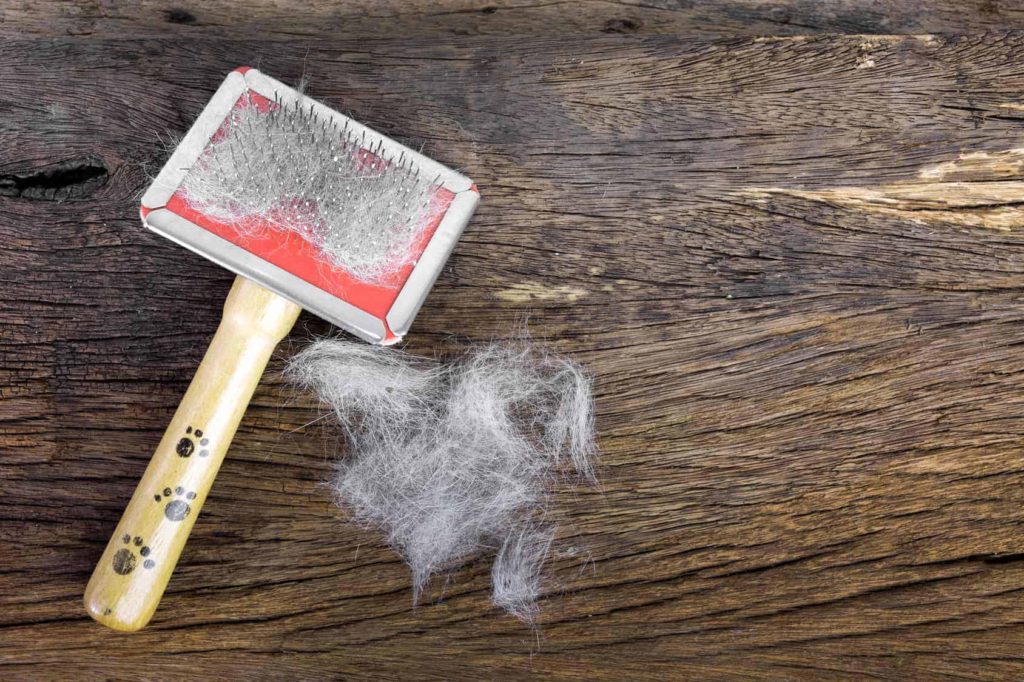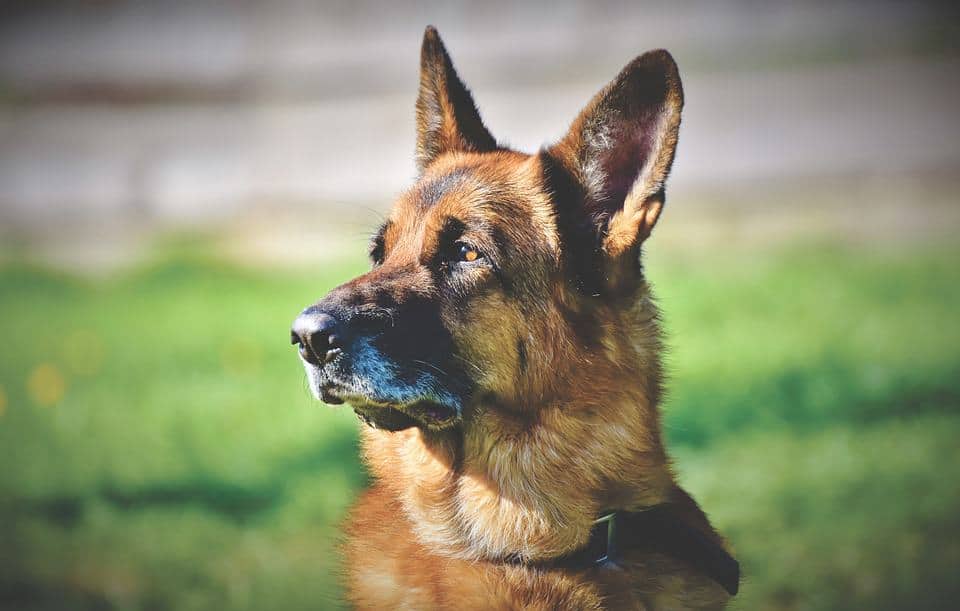All dogs shed, but do German shepherds shed a lot? Are there some breeds that tend to shed more than others? While it’s true that every dog does shed, excessive shedding should be a cause for concern. This type of shedding can indicate an underlying condition. Here, I’ll cover what types of dogs shed a lot, what excessive shedding can mean, and how you can keep your pet hair problem under control.
Do german shepherds shed a lot? Yes, they do. German shepherds, just like Labradors, are considered working breeds. These dogs usually have two coats, which means twice the mess. Fortunately, there are some things you can do to keep your home pet-hair-free, such as bathing your dog once a week, brush or comb them daily, and vacuum your home often, using a model that’s specifically designed to pick up pet hair.
Continue reading to find out what type of shedding is normal and what signs and symptoms to look for in your pet that can indicate that their shedding is related to an underlying health condition.
When You Should Be Concerned with Shedding
So, what’s considered normal dog shedding? Most breeds of dogs will lose fur year-round. However, some breeds will shed heavily once or twice a year, based on the season.
If your dog seems healthy and sheds a lot regularly, it may just be the breed. Most types of normal shedding involve the loss of the undercoat and some regular loss of fur. This type of shedding occurs year-round, which is why you’ll see pet hair all over the furniture and your clothing, any day of the year.
However, if you notice patches of missing fur on your dog’s body, then it may be time to make an appointment with your vet.
Some breeds will experience seasonal shedding. This will usually occur in the spring and/or the fall. This type of shedding will occur evenly across the entire body and often happens each year on a cycle. This dog shedding is common among cold-weather breeds such as huskies. Seasonal shedding is not something you should be concerned about, and it can easily be managed with daily brushing.

Excessive Shedding
Excessive shedding can be almost impossible to manage since your pet’s hair will cling to your clothes, upholstery, and furniture. The best way to deal with this situation is to brush your pet daily. The type of brush you’ll use will depend on their coat. You should also consider adding healthy fat to your pet’s food and increase the frequency in which you bathe them during the summer. Bathing will help to remove some of the built-up dead hair, which can help to reduce the amount of hair in the home. However, you’ll also need to be careful about overdoing it since bathing a dog too frequently can strip their skin of important oils.
Shedding or Fur Loss?
Is there a difference between fur loss and shedding? There is. Some dogs may lose hair due to adrenal diseases such as Cushing’s disease. Infections and illness-related traumas can also be to blame. In cases such as these, you’ll notice patches of hair loss instead of general shedding. Dogs with hypothyroid issues will have symmetrical hair loss, but the hairless will be isolated to certain areas of the body.
Unusual Hair Loss
The following types of hair loss can indicate that your pet has an underlying health issue. Should you notice any of the issues below, make an appointment with your dog’s vet for an assessment:
- Hair is brittle and dry
- Clumps of hair loss
- Bald patches
Dog does not like being touched- Hair loss is also accompanied by skin issues
Hair loss can be caused by several factors such as hormonal imbalances or allergies.
Main Causes of Hair Loss
If your pet’s hair is falling out, it could be an allergic reaction due to the following:
- Medication
- New shampoo
- Pest bites
To diagnose an allergic response, the first step is to remove any possible allergens from your dog’s environment. These items should be slowly reintroduced back into your dog’s life one by one to pinpoint the culprit.
Hormonal Imbalance
Thyroid issues in your dog can cause the fur to fall out or become brittle. Hypothyroidism is a common condition in dogs, and it can easily be treated with ongoing use of medication. Other types of hormonal issues will involve too much or too little estrogen, testosterone, or progesterone, all of which can cause a dog to shed excessively.
When a dog is pregnant and lactating, they will also experience some hair loss. However, if hair loss is excessive, your dog may need to take supplements.
Dietary Issues
A poor diet can also be to blame and can result in excessive hair loss. A blood test can determine if your pet is experiencing some type of mineral deficiency or if their levels are too high.
Major Stressors
If there has been a major change in your home then your dog’s body may simply be reacting to this stress. You should always take into consideration that your pet may be shedding more than usual because of an emotional response. This can happen with divorce, if a new baby or another dog is brought home, or if a person has died. Some dogs may be even more sensitive to stress or changes in the home and will chew themselves excessively. If this is the root cause of your pet’s hair loss then some extra time together and the addition of a healthy oil can make a big difference.
Skin Conditions
There are several different types of skin conditions that can cause hair loss including ringworm, dermatitis, mites, and mange, not to mention a variety of fungal or bacterial infections. If the hair loss is patchy and feels tender, make sure you make an appointment with your vet.

German Shepherds and Shedding
These dogs are not only huge and majestic, but they’re incredibly smart, energetic, and intelligent. If you’re thinking of adopting one, then you may be concerned that German shepherds shed excessively. This can be an issue in some homes if a family member is allergic to pet hair or pet dander.
Unfortunately, these dogs do shed, but just how much do German shepherds shed?
The answer is: a lot. You can plan on spending quite a bit of time vacuuming and sweeping up after your dog at least two to three times a week. You’ll also need to buy a good lint roller and use it often unless you want to go into work covered in pet hair.
Do Labradors Shed a Lot?
Yes, they do. Most working dogs are heavy shedders. This is especially true for breeds that originated in cold regions. Regardless of the color of the lab, they all shed quite a bit. Most breeds that weren’t bred for work or those that were bred in a warmer climate have just a single hair coat, which is more than sufficient to keep them comfortable and protect their skin.
Dogs that were bred in colder regions have two layers of hair for protection against the elements. The dog’s inner coat is very dense and made up of short hairs that are designed to trap body heat while also protecting the skin from the bitter cold. The outer coat is waterproof and longer than the inner coat. These hairs are much tougher and designed to repel both dirt and water.
But a double coat means the dog has two layers to shed. When these dogs are exposed to the elements, their coat may shed in a variety of phases based on the time of year. Their inner coat will shed completely in the springtime. This major shed is triggered by the longer days, which signal that warmer weather is approaching.
The Season of Shedding
A dog’s coat will respond to daylight. As I mentioned, when the days get longer, the dog will begin to shed heavily. On the same token, when the days get shorter, the summer hair will be pushed out to make room for new hair. So, it’s perfectly normal to notice an increase in shedding for two to three weeks during the fall.
Related Questions
How Can I Get a Handle on Dog Shedding in the Home?
Now that you know German Shepherds, labs, and other working dogs tend to shed a lot regularly and seasonally, there are some things you can do in the home that will help to cut back on the amount of pet hair you have to deal with. First, use the best vacuum for pet hair. I recommend the Shark Navigator Lift-Away Professional NV356E. This model comes with plenty of attachments, so you can focus on cleaning those hard to reach areas where pet hair tends to accumulate, such as under the couch or the stairs.
What Cleaning Products Work the Best for Dog Urine?
This can really depend on how old or new the stain is. For older stains, you may need to use an enzyme-based product. These products work by actually consuming the protein in the urine, instead of just masking the smell. Another option is using a solution that consists of white vinegar, baking soda, and dish soap. For more information on how to keep your home looking and smelling great, click here to read my article on how to clean dog pee off couch.
Final Thoughts
Now that you know do German shepherds shed a lot, and that most breeds of working dogs do, you can use the right tools to keep your pet and home looking great. Brush or comb your dog daily. Bathe them once a week. Vacuum your home daily using a model that comes equipped with attachments designed to help you reach tight spaces and other hard to access areas. Remember, if you think your pet is shedding excessively and is also showing other signs and symptoms that can indicate an underlying illness, then it’s time to make an appoint with your vet for an assessment.
